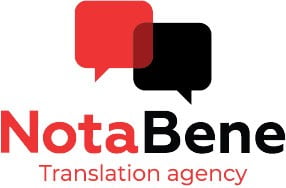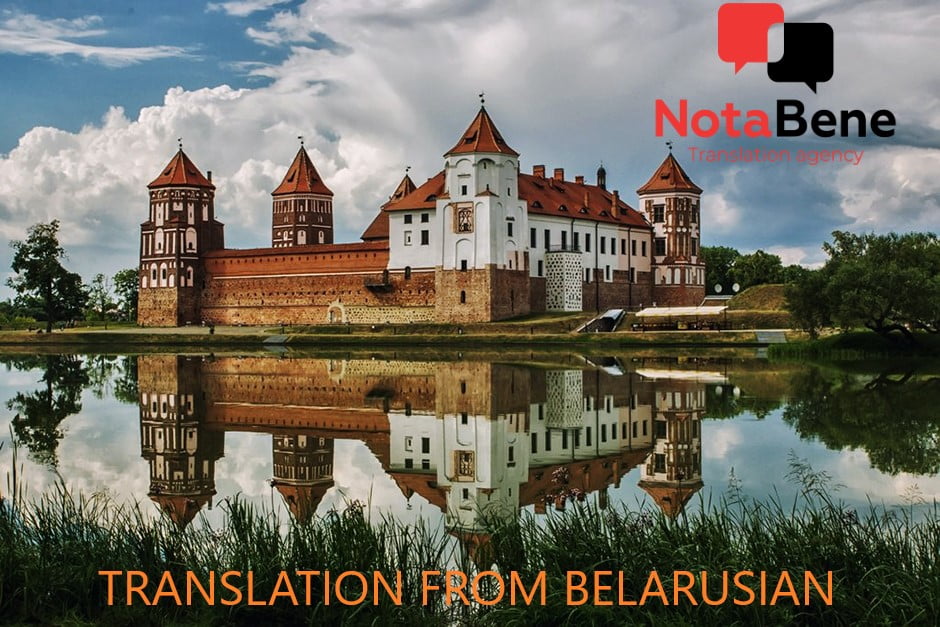Order translation from Belarusian or into Belarusian at NotaBene Agency in Poland!
NotaBene Translation Agency is an experienced supplier of translation from Belarusian into Polish and vice versa for any documents or texts.
What types of texts does NotaBene Translation Agency work with?
– Technical translation from Belarusian — we translate any texts in electronics, aviation and shipbuilding, agriculture, industry, oil and chemistry, etc. For this purpose, we pick translators who understand the specific nature of a given industry.
– Translations for the IT sector from and into Belarusian for the localization of applications, games, software and websites.
– Medical translation from Belarusian — books, manuals, articles in specialized printed and online publications, clinical records, correspondence with medical institutions, transcriptions and translations of test results, instructions for medicines and many other types of texts. This kind of translation requires flawless knowledge of medical terminology and focus on detail to rule out ambiguity, because the result can affect the health or life of many people.
– Legal translations: translation of corporate documents: statutes, registration deeds, articles of incorporation, contracts, powers of attorney, court records and many other similar documents.
– Financial translation: this type of translation includes the translation of balance sheets, tax returns, payment invoices, waybills, tender documents, etc.
– Literary or fiction translation is the translation from Belarusian of fiction, marketing and advertising materials. Unlike the previous types of translation, in this case there is more room for a translator’s creativity, because there is no need for “word for word” translation. The most important thing is that the translated material produces the same impact as the original, while an excellent translation may even make it better.
Please note that the translation mentioned is certified by an agency seal only. If you need sworn translation, kindly notify your manager in advance. Sworn translation is possible only for certain languages.
How to have a translation from Belarusian into English, Russian, Polish or Ukrainian and vice versa?
First of all, you need to order it. To do so, send your source text and specify your requirements for the translation from Belarusian. A customer service specialist at the Nota Bene Translation Agency will prepare a ToR based on the specific features of the order. If the project involves more than one job, a unique glossary is created to ensure the consistency and proper use of terminology.
An entire team of several professionals normally works on a job: a translator, proofreader, editor, quality controller, layout designer and manager who will be available during working hours. In order to rule out human errors, the translation agency uses modern services to check punctuation, idioms, numerical expressions, and formulas. The material is also reviewed by the chief editor.
Confidentiality of translated data is ensured by a special NDA, whenever a customer wishes to have one. Documents can be delivered to any country.
We very rarely apply additional fees for “urgency” or “specialized subjects”, so you can be sure that the price will not rise when the project is delivered. It is true that in rare cases, such as “we need to have it yesterday” instances, and when a customer is willing to pay a higher rate for the team to work outside normal working hours, at night or on weekends, the fee might be increased, but this is always negotiated with the customer in advance.
Exciting facts about Belarusian
Belarusian, along with Russian and Ukrainian, belongs to the group of the East Slavic languages. It is mainly used in the Republic of Belarus, where it is the official language. A small number of people also speak it in Ukraine, Poland and the Czech Republic. Today, Belarusian is spoken by some 6.5 million people (according to 2009 data).
Belarusian has had three alphabets in its history — Cyrillic, Latin and Arabic. The first alphabet has been used since the 14th century, while the Latin alphabet was introduced later, when the territory of modern Belarus became the nucleus of the Grand Duchy of Lithuania (Polotsk was the capital for a long time). The Arabic script was used by Belarusian (Lithuanian) Tatars, who began to speak the local language, but retained their customary Arabic script.
It is believed that Belarusian started evolving as an independent language in the 14th century. It was then that the language we now call Old Belarusian was formed. By 1696, it had become an official language of the Grand Duchy of Lithuania (alongside Latin and Polish). After the partitions of Poland, it was replaced by Russian.
The Belarusian language has retained a large number of words with old Slavic roots. It has also borrowed from Polish, Russian, German and the ubiquitous Latin language.
Modern Belarusian has two grammatical norms — the official orthography and the so-called Tarashkevich norm, which was introduced in 1918 by B.A. Tarashkevich, a politician, linguist and translator. It became necessary in connection with Belarus gaining its independence and the creation of an independent Belarusian state — the Belarusian People’s Republic (BRL). Tarashkyevitsa had been officially used until 1933, when the Belarusian language was reformed and given the unofficial name of “Narkomovka.” Its characteristic feature was the forcible introduction of norms typical of the Russian language (Russification).
One of the characteristic features of the Belarusian language is the letter Ў (“U neskladowaje”). Moreover, this letter has become a characteristic symbol of the language, and in 2003 even a Ў monument was erected in Polotsk. It is also often used as a logo for various media projects connected with the Belarusian language.
We have been in business for over 20 years and during that time we have learned to work well. Trust us with your translation from Belarusian and get a great result at a reasonable price.








